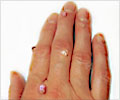According to a Swedish national registry study, the incidence of genital warts, or condylomata, declined by 93 per cent in girls given the HPV vaccine before the age of 14.

The research team has not yet studied the results of cervical cancer, which takes longer to develop. The effect on condyloma was, however, clear: subjects who were vaccinated before the age of 14 showed a 93 per cent decrease in condyloma. It is already known that the vaccine has to be taken before an infection with HPV (human papillomavirus) for it to work, and the researchers noted a level of protection below 50 per cent for those who vaccinated themselves after the age of 20.
The researchers also found that it was 15 times more common for daughters of academically educated parents to vaccinate themselves than for the daughters of less-educated parents. The educational level of the mother had most impact; it was eight times more common for a girl to be vaccinated if her mother was academically educated, as opposed to four times more common if her father was.
Opportunistic HPV vaccination was introduced in 2007 in Sweden offering girls between 13 and 17 (only) the possibility to vaccinate at a reduced price. Since 2012, the vaccine is part of the general vaccination programme and is thus offered free of charge to all girls between 10 and 12 along with a catch-up vaccination for girls and young women between 13 and 18.
"Our study supports the notion that the vaccine should be given at young age," says Dr Lisen Arnheim-Dahlström, Research Associate at the Department of Medical Epidemiology and Statistics at Karolinska Institutet. "When the vaccine was offered at a reduced price, the distribution was very unequal. Now that the vaccine is free and offered through the schools, it will be more evenly distributed in the population."
Source-Eurekalert











